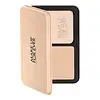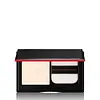Make Up For Ever HD Skin Powder Foundation Versus Shiseido Synchro Skin Invisible Silk Pressed Powder
What's inside
What's inside
 Key Ingredients
Key Ingredients

 Benefits
Benefits

 Concerns
Concerns

 Ingredients Side-by-side
Ingredients Side-by-side

Synthetic Fluorphlogopite
Boron Nitride
AbsorbentPentaerythrityl Tetraisostearate
EmollientSilica
AbrasivePolymethyl Methacrylate
Alumina
AbrasiveZinc Laurate
Methicone
EmollientDimethicone
EmollientCaprylyl Glycol
EmollientEthylhexylglycerin
Skin ConditioningSodium Dehydroacetate
PreservativeAluminum Hydroxide
EmollientHydrogen Dimethicone
Tocopherol
AntioxidantCI 77491
Cosmetic ColorantCI 77492
Cosmetic ColorantCI 77499
Cosmetic ColorantCI 77891
Cosmetic ColorantCI 77163
Cosmetic ColorantSynthetic Fluorphlogopite, Boron Nitride, Pentaerythrityl Tetraisostearate, Silica, Polymethyl Methacrylate, Alumina, Zinc Laurate, Methicone, Dimethicone, Caprylyl Glycol, Ethylhexylglycerin, Sodium Dehydroacetate, Aluminum Hydroxide, Hydrogen Dimethicone, Tocopherol, CI 77491, CI 77492, CI 77499, CI 77891, CI 77163
Talc
AbrasiveSynthetic Fluorphlogopite
Mica
Cosmetic ColorantCaprylic/Capric Triglyceride
MaskingBoron Nitride
AbsorbentDiphenyl Dimethicone/Vinyl Diphenyl Dimethicone/Silsesquioxane Crosspolymer
Nylon-12
Silica
AbrasiveDimethicone
EmollientLauroyl Lysine
Skin ConditioningStearoxymethicone/Dimethicone Copolymer
EmollientDiphenylsiloxy Phenyl Trimethicone
Skin ConditioningPCA Dimethicone
Skin ConditioningAmodimethicone
Hydrogen Dimethicone
Sorbitan Sesquiisostearate
EmulsifyingPolymethyl Methacrylate
Chlorphenesin
AntimicrobialCI 77491
Cosmetic ColorantCI 77492
Cosmetic ColorantTocopherol
AntioxidantCI 77891
Cosmetic ColorantNacre Powder
AbrasiveWater
Skin ConditioningMethyl Methacrylate/Acrylonitrile Copolymer
CI 77499
Cosmetic ColorantTriethoxycaprylylsilane
Polymethylsilsesquioxane
Dimethicone/Vinyl Dimethicone Crosspolymer
Skin ConditioningPolyquaternium-51
Skin ConditioningStearic Acid
CleansingIsobutane
Aluminum Hydroxide
EmollientIsopentane
SolventCellulose
AbsorbentPhenoxyethanol
PreservativeButylene Glycol
HumectantThymus Serpyllum Extract
Skin ConditioningTalc, Synthetic Fluorphlogopite, Mica, Caprylic/Capric Triglyceride, Boron Nitride, Diphenyl Dimethicone/Vinyl Diphenyl Dimethicone/Silsesquioxane Crosspolymer, Nylon-12, Silica, Dimethicone, Lauroyl Lysine, Stearoxymethicone/Dimethicone Copolymer, Diphenylsiloxy Phenyl Trimethicone, PCA Dimethicone, Amodimethicone, Hydrogen Dimethicone, Sorbitan Sesquiisostearate, Polymethyl Methacrylate, Chlorphenesin, CI 77491, CI 77492, Tocopherol, CI 77891, Nacre Powder, Water, Methyl Methacrylate/Acrylonitrile Copolymer, CI 77499, Triethoxycaprylylsilane, Polymethylsilsesquioxane, Dimethicone/Vinyl Dimethicone Crosspolymer, Polyquaternium-51, Stearic Acid, Isobutane, Aluminum Hydroxide, Isopentane, Cellulose, Phenoxyethanol, Butylene Glycol, Thymus Serpyllum Extract
Ingredients Explained
These ingredients are found in both products.
Ingredients higher up in an ingredient list are typically present in a larger amount.
Aluminum Hydroxide is a form of aluminum. It can be naturally found in nature as the mineral gibbsite. In cosmetics, Aluminum Hydroxide is used as a colorant, pH adjuster, and absorbent.
As a colorant, Aluminum Hydroxide may add opacity, or reduce the transparency. Aluminum hydroxide is contains both basic and acidic properties.
According to manufacturers, this ingredient is an emollient and humectant. This means it helps hydrate the skin.
In medicine, this ingredient is used to help relieve heartburn and help heal ulcers.
There is currently no credible scientific evidence linking aluminum hydroxide in cosmetics to increased cancer risk.
Major health organizations allow the use of aluminum hydroxide in personal care products and have not flagged it as a carcinogenic risk at typical usage levels.
Learn more about Aluminum HydroxideBoron Nitride is compound consisting of boron and nitrogen. It is used to absorb oil and modify adherence/ slip in products.
This means it is often used in makeup products to help them last longer.
Ci 77491 is also hydrated iron III oxide. It's sole purpose is to give a red/pink hue to products.
Iron III oxides are classified as inorganic chemicals for coloring.
Synthetically created Ci 77491 is considered safer than those naturally found. This is because the synthetically created version may contain less impurities. Iron oxides are generally non-toxic and non-allergenic.
Learn more about CI 77491Ci 77492 is also hydrated iron III oxide. It's sole purpose is to give a yellow hue to products.
Iron III oxides are classified as inorganic chemicals for coloring.
Synthetically created Ci 77492 is considered safer than those naturally found. This is because the synthetically created version may contain less impurities. Iron oxides are generally non-toxic and non-allergenic.
Learn more about CI 77492Ci 77499 is also hydrated iron III oxide. It is created from mixing red and black iron oxides. This helps give shades of darkness to a product.
Iron III oxides are classified as inorganic chemicals for coloring.
Ci 77891 is a white pigment from Titanium dioxide. It is naturally found in minerals such as rutile and ilmenite.
It's main function is to add a white color to cosmetics. It can also be mixed with other colors to create different shades.
Ci 77891 is commonly found in sunscreens due to its ability to block UV rays.
Learn more about CI 77891Dimethicone is a type of synthetic silicone created from natural materials such as quartz.
What it does:
Dimethicone comes in different viscosities:
Depending on the viscosity, dimethicone has different properties.
Ingredients lists don't always show which type is used, so we recommend reaching out to the brand if you have questions about the viscosity.
This ingredient is unlikely to cause irritation because it does not get absorbed into skin. However, people with silicone allergies should be careful about using this ingredient.
Note: Dimethicone may contribute to pilling. This is because it is not oil or water soluble, so pilling may occur when layered with products. When mixed with heavy oils in a formula, the outcome is also quite greasy.
Learn more about DimethiconeHydrogen Dimethicone is a type of silicone.
This ingredient is also known as PMMA. It is a polymer microsphere, composed of tiny, perfectly spherical particles formed from repeating units.
In cosmetics, PMMA is mainly used to give a soft or blurring effect. The transparent particles are able to scatter light and help reduce the appearance of fine-lines and imperfections.
PMMA is also able to enhance the texture of products by add a smooth feel.
Learn more about Polymethyl MethacrylateSilica, also known as silicon dioxide, is a naturally occurring mineral. It is used as a fine, spherical, and porous powder in cosmetics.
Though it has exfoliant properties, the function of silica varies depending on the product.
The unique structure of silica enhances the spreadability and adds smoothness, making it a great texture enhancer.
It is also used as an active carrier, emulsifier, and mattifier due to its ability to absorb excess oil.
In some products, tiny microneedles called spicules are made from silica or hydrolyzed sponge. When you rub them in, they lightly polish away dead skin layers and enhance the penetration of active ingredients.
Learn more about SilicaSynthetic Fluorphlogopite is the synthethic version of mica. It consists of fluorine, aluminum and silicate.
Synthetic Fluorphlogopite is used to add volume to products.
It is considered non-irritating on the skin.
Learn more about Synthetic FluorphlogopiteTocopherol (also known as Vitamin E) is a common antioxidant used to help protect the skin from free-radicals and strengthen the skin barrier. It's also fat soluble - this means our skin is great at absorbing it.
Vitamin E also helps keep your natural skin lipids healthy. Your lipid skin barrier naturally consists of lipids, ceramides, and fatty acids. Vitamin E offers extra protection for your skin’s lipid barrier, keeping your skin healthy and nourished.
Another benefit is a bit of UV protection. Vitamin E helps reduce the damage caused by UVB rays. (It should not replace your sunscreen). Combining it with Vitamin C can decrease sunburned cells and hyperpigmentation after UV exposure.
You might have noticed Vitamin E + C often paired together. This is because it is great at stabilizing Vitamin C. Using the two together helps increase the effectiveness of both ingredients.
There are often claims that Vitamin E can reduce/prevent scarring, but these claims haven't been confirmed by scientific research.
Learn more about Tocopherol